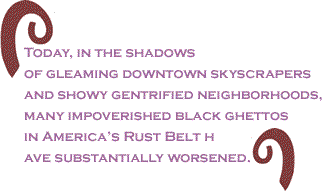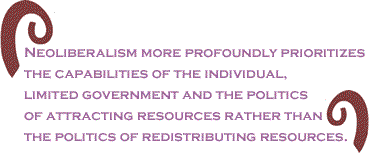
|
|||||||||||||||||||||
 |
|||||||||||||||||||||
 |
|
|
The brighter that city-centers in the northern U.S. glow, the rustier the ghettos in those cities become. Such is the price for globalization. Unemployment, underemployment, hopelessness and poverty have been “searing” the inner cities of Chicago, Cleveland, Detroit, Philadelphia and St. Louis for 40 years, but the neoliberal policies and programs that began in the 1990s, fueled by the luster of globalization, have further marginalized the residents of the Rust Belt’s black ghettos, further balkanized and stigmatized them and further deepened their poverty. Those are among the findings in a new book, “Cities and Race: America’s New Black Ghetto” (Routledge), by David Wilson, a professor of geography at the University of Illinois. According to Wilson, “Today, in the shadows of gleaming downtown skyscrapers and showy gentrified neighborhoods, many impoverished black ghettos in America’s Rust Belt have substantially worsened.” Wilson, the author of multiple studies of Chicago, argues that the push to “concentrate and expand ‘compatible’ land uses and populations is, more meticulously than ever before, mooring black bodies in a complex of inferior schools, decrepit homes, isolated social spaces and glaringly underfunded institutions.”
And while he concedes that U.S. ghettos have long been “warehouses for the racial poor,” and that being stigmatized by “negative representations” is nothing new for the residents of ghettos, Wilson says that a “more pronounced deprivation” now marks these areas: Ghettos are increasingly being “narrated through” the metaphor of an “animate place plagued by consumptive degeneracy, where living beings have fallen into a state of habitually ‘eating’ social resources – goods, service and subsidies.” For his study, Wilson analyzed newspaper stories about city growth and redevelopment in six major daily papers in the Midwest and in The New York Times; conducted discussions with local planners, city officials, city program heads and representatives, community activists, residents and youth in Chicago, Cleveland, Indianapolis, Philadelphia, St. Louis and New York; and conducted an analysis of the narrative used by syndicated neoconservative radio commentator Mancow Muller. Neoliberalism, defined by Wilson as the form of governance that “more profoundly prioritizes the capabilities of the individual, limited government and the politics of attracting resources rather than the politics of redistributing resources,” spawns what Wilson calls a “growth machine”: a constellation of local agencies and institutions, prominent builders, developers, government, real estate agents, the media and local utilities that form a coalition to “attract more business and industry, build more conspicuous consumption neighborhoods and vibrant, lavish downtowns and re-entrepreneurialize local business climates.” In building these showcase city centers, these coalitions also are bricking in the “glocal black ghetto,” a term Wilson coined for the “increasingly impoverished and impugned crystallized zone of human discard” in the global era. As leaders and residents of the “new black ghetto” are struggling to upgrade their communities, they face a formidable task: “the accelerated push to make and protect downtown revitalized landscapes of consumption, pleasure and affluent residency.”
Such landscapes already have emerged: the Loop-Gentrification Complex in Chicago, the Circle Centre Mall Axis in Indianapolis, Soulard-Gentry Boulevard in St. Louis and the Public Square-Historic Gateway Cluster in Cleveland. Among the programs, policies and institutions that Wilson scrutinizes in his examination of the American black ghetto is something he calls the “prison industrial complex,” another “warehousing instrument,” he wrote, that, now, with crushing overcrowding and significantly reduced funding, is beginning to implode. Other forces that are wreaking havoc on the ghetto today include the Faith-Based Resource Provision and Workfare. But one of Wilson’s most disturbing findings involves the consequences of President George W. Bush’s 2002 initiative, “No Child Left Behind.” Tried first in Texas, the program, now national in scope, was funded at the rate of $1 billion a year for five years and challenges states, schools and districts to carry out the president’s notion of an “educational miracle.” In reality, the program has become “the new unhidden hand in educational settings that unleashes a ‘get-tough-entrepreneurial’ wrath on black, poor kids,” Wilson wrote. Since school aid is tied to performance, schools have discovered that they are “rewarded” for removing or expelling bad test-takers and other students with a range of “problems” large and small. “Select purging” – both on a short- and long-term basis – is “widespread” in our cities’ ghettos, Wilson wrote. “Key decision makers, compelled to protect their school’s lifeblood - money - are ironically turning against the most vulnerable students to protect the possibility of providing a more enriching experience for the generic ‘student.’ " Andrea Lynn is Humanities Editor at the News Bureau of the University of Illinois at Urbana-Champaign. Her email address is [email protected]. |
|
| Home | |
| March
29, 2007 Issue 223 |
||||||||||||||
|
||||||||||||||
| Printer Friendly Version in resizeable plain text format | ||||||||||||||
 |
||||||||||||||
|
||||||||||||||
 |
||||||||||||||
 |
||||||||||||||
 |
||||||||||||||
| |
||||||||||||||
| |
||||||||||||||






























